Zoo
![]()
This article is about zoological gardens. For other meanings, see Zoo (disambiguation).
A zoological garden (Ancient Greek ζῷον zōon [dzɔ̂ːon], German 'Lebewesen, Tier'), in short zoo, also Tiergarten or Tierpark, is a large, usually park-like facility for the keeping and public display of various animal species. Based on historical development, it is primarily scientifically managed parks that are considered zoos. However, the general public also considers other animal enclosures, such as larger game preserves and aviary collections, to be zoos. Zoos serve education, research, recreation and nature conservation, for example by breeding rare animals and releasing them into the wild, but are controversial from an animal welfare or animal rights position.
In German law, the term zoo is legally defined in § 42 of the Federal Nature Conservation Act as a "permanent institution in which living animals of wild species are kept for the purpose of exhibition for a period of at least seven days a year", with the exception of circuses and pet shops.
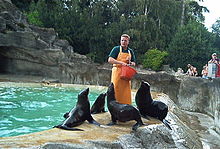
Feeding the seals at Hagenbeck Zoo
History
The earliest archaeological evidence of zoo-like animal husbandry was found in Egypt: Around 3500 BC, wild cats, hippos, elephants, baboons, and now extinct animals such as the North African hartebeest and an aurochs, among others, were kept at Hierakonpolis. Other surviving sites date back to China, where animals were kept at the court of a Xia Dynasty emperor around 2000 BC. Another park was built by Wu-Wang, the ancestor of the Zhou dynasty, around 1150 BC. Also called the Park of Intelligence, it still existed around the middle of the 4th century BC and housed mammals, birds, turtles and fish. In the Ancient Near East, exotic animals were exchanged among rulers early on or served as tribute. Thus, among the tribute of Sidon and Arwad to the Middle Assyrian ruler Tiglat-pileser I were a female monkey and a crocodile; Aššur-bēl-kala received a female monkey and a "river man" (amīl nāri, perhaps an ichneumon or seal) as a gift from the Egyptian pharaoh. Wild cattle (burḫis and tešēnu) and camels he traded in from the mountains of the East.
Also known was the complex similar to the later European menageries of the Aztec ruler Moctezuma II. (1465-1520), of which Meyers Konversations-Lexikon writes:
"The Spaniards, on conquering Mexico, were surprised by the sight of the imperial menagerie, a long series of water tanks, birdhouses, and cages of wild animals. Especially excellent were the ornamental birds from all parts of the Aztec empire, but there was no lack of snakes. To the birds of prey 500 turkeys a day served for food. 300 men were employed in the care of the water-birds, which were kept on ten ponds, as many in that of the beasts of prey."
- Meyers Konversations-Lexikon 1889
In Europe, monasteries kept a small stock of animals, as did the monastery of St. Gall in the 10th century. The kennels there housed all kinds of game and poultry, some of which lived in the nearby Alps or were given to the monastery as gifts from foreign guests.
In addition, countless animal enclosures were maintained for hunting purposes in the Middle Ages, e.g. the deer moat at Frankfurt am Main. Besides hunting, display was the most important branch in the founding of menageries. Menageries were mostly linked to the court of a nobleman. Probably the most important was the royal menagerie in the Tower of London, which began in 1235 under Henry III of England (1207-1272). In the 16th century, the Italian aristocracy also began to keep "exotic" animals in the gardens of their residences on the outskirts of the cities. The menageries really blossomed after Louis XIV (1638-1715) had the hunting pavilion in the palace gardens at Versailles turned into a complex of enclosures for "exotic" animals in 1662. Many absolutist rulers used the display of exotic animals, plants, and other natural and geological objects to emphasize their wealth and exclusivity. The courtly menageries developed into a status symbol in the course of the early modern period.
Starting from the menageries and connected with the scientific urge to research, the demand to be able to study and observe living animals more closely developed at the end of the 18th century. Since the conditions under which animals were kept in the court menageries partly contradicted the living habits of the animals, most of which were caught in the wild and left to languish, they were unsuitable for scientific research. In addition, access to these menageries was regulated and there was a demand to open the menageries to the general public. After the successive dissolution of the princely private menageries around 1800, the wandering animal collections that emerged as commercial enterprises initially pursued similar goals to the first public menageries, but in the course of the 19th century, in contrast to the intentions of the zoos, they devoted themselves to the public's curiosity.
The oldest zoo in the world still in existence is the Schönbrunn Zoo in Vienna, founded in 1752 by Franz I Stephan. It was initially a courtly menagerie with a private character and only opened its gates to the general public in 1778. The Schönbrunn Zoo is also the only zoo in which animals are kept in baroque menagerie buildings that have been adapted to modern zoo animal husbandry. According to its self-image and the current international self-definition of zoos, it is today a scientifically managed zoological garden, which sees its main task in the protection of species and nature as well as in the legally prescribed educational mission. The preserved parts of the baroque ensemble, which have been supplemented with elements of modern zoo architecture for some years now, nevertheless still give a good impression of the 18th century menagerie buildings modelled on Versailles.
The Ménagerie du Jardin des Plantes in Paris is considered to be the oldest zoo to have been run scientifically from the beginning. It was founded in 1793 after the Versailles Menagerie was finally dissolved. From the beginning it was open to everyone and offered renowned natural scientists of the time - among them Georges Cuvier, Étienne Geoffroy Saint-Hilaire, Bernard Germain Lacépède and Jean-Baptiste de Lamarck - the opportunity to study "exotic" animals.
The term "zoological garden" was first used at the London Zoo.
On May 30, 1841, a Whit Sunday, the innkeeper Schardel Heinrich Berg opened the first German "Thiergarten" right behind his pub "Zum letzter Heller". He had purchased the pub, which was located in what is now the Horn district of Hamburg, a few weeks earlier. This zoo contained about 60 species of animals, which are described in a "Guide to the Zoological or Animal Garden" (in the holdings of the Museum of Hamburg History). In 1843 this zoo is also presented in detail in the Hamburg address book. But already in 1845 the zoo had to close again due to a lack of visitors, as the people of Hamburg were busy with other things than visiting the zoo because of the great Hamburg fire of 1842.
On 1 August 1844, the oldest surviving zoo in Germany, the Zoological Garden in Berlin, opened its doors. From the 1860s onwards, a wave of bourgeois zoo foundations followed in almost all major cities.
The gridless animal enclosure invented by Carl Hagenbeck in 1896 was first implemented in Hagenbeck's zoo in Hamburg. In it, he tried to do without bars wherever possible and to base the design of the animals' environment on their habitats. It established itself as a paradigm in zoo design in the course of the 20th century.
From the end of the 19th century until the first half of the 20th century, it was common to put people who were perceived as "exotic" on display in the context of so-called ethnological shows. This often took place in zoos, as it was possible to place people here in an environment with animal life that was familiar to them, in order to create a supposed "authenticity". This was also intended to underpin the colonial states' claim to power, that they were called upon to tame the "wild". Some 300 different non-European groups of people were exhibited in "anthropological-zoological exhibitions" with a strong alienation of their customs for entertainment purposes in the sense of stereotypes and ethnic chauvinism. In 1875 Carl Hagenbeck opened one of the first Völkerschauen. Other commercially successful exhibitors followed. After the Second World War, there were isolated events in zoos that were associated with the ethnological shows that are now considered racist. The "African Village", an idea of the Augsburg Zoo in 2005, was controversially discussed in this context.
Another wave of zoos was founded in Europe in the 1930s. With the increasing mobility of the population, many smaller facilities have been established in the countryside since the 1960s.
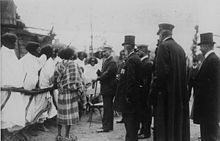
Kaiser Wilhelm II visits a group of Ethiopians at a folk show in Hagenbeck Zoo in 1909
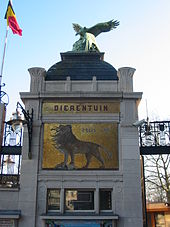
Entrance gate Antwerp Zoo, founded 1843

Lion in the Berlin Zoological Garden, which was the model for the lion statues of the Kaiser Wilhelm National Monument, around 1899.
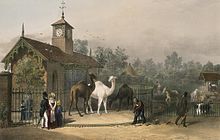
View of the London Zoological Gardens, painting from 1835
Main Tasks
The main tasks of a zoo have shifted over the course of history from the simple exhibition of "exotic" animals to the research of animal species as well as conservation breeding. Almost 60 years ago, the founder of zoo biology, Heini Hediger, already defined the main tasks of zoos as
- Education,
- Recreation,
- Research and
- Conservation.
This has not changed until today. Above all, the protection of nature and species is the focus of the vast majority of scientifically managed zoos today. Many zoos supervise and finance their own conservation projects in situ, i.e. in the habitat of the wild animals. In German-speaking countries, more than 45 zoos have joined forces in the Stiftung Artenschutz (Species Protection Foundation) to jointly promote species protection projects.
An international umbrella function of various conservation breeding programmes is carried out by the World Association of Zoos and Aquariums WAZA, which has 22 regional or national zoo and aquarium associations and 213 individual zoos and aquariums in 46 countries as institutional members.
Species that would already be extinct without conservation breeding programs of zoological gardens include: Bison, Przewalski's horses, Mhorr gazelles, California condors, David's deer (Milus) and Oryx antelopes.

Przewalski's horses in Prague Zoo
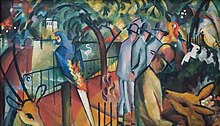
Zoological Garden. Painting by August Macke
Search within the encyclopedia